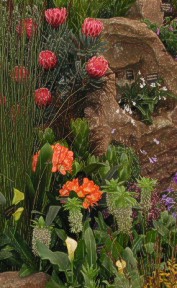 |
|
|
This is just as true for a tree when you are talking about mulching. Mulch is good. Mulch is almost always good for the soil in our gardens. It keeps the surface cool, discourages weed growth and, if we are talking chips or eucalyptus mulch (or compost or recovered wood products), gradually breaks down to improve the soil. But how you use it makes a difference. We are realizing with more and more certainty that planting depth is a major factor in whether a tree lives or dies. Roots emerge at the base of the trunk: the top of this region from which the roots emerge should be just at ground level when a tree is planted. You must always check this, and cannot even trust the older idea of planting it at the same level that it was in at the nursery. Sometimes a tree will come to you already too deep in the pot, and will need to have a little soil removed to have the main roots just showing. However, it is no good planting at the right depth and then covering the trunk base with thick mulch. The roots of a tree have evolved to be underground: mulch over them is fine, and here is where the doughnut shape comes into play. A nice two or three-inch depth of a good mulch is great over the whole soil surface around a tree, except that it must not touch the trunk. Do your mulching leaving a few inches out from the trunk as the hole in the doughnut: dust this open space with a little mulch to get the uniformity of color if you wish. The trunk of a tree requires the drier atmosphere of the open air, and mulch piled high on the base in a volcano shape can cause rot and sometimes root growth where you don't want it. Volcanoes are bad, doughnuts are good. If only all of life's questions were as easily resolved.
|
|